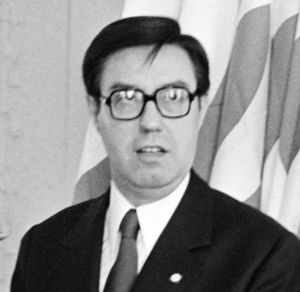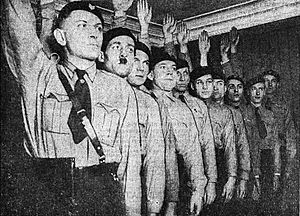Pierre Sidos facts for kids
Quick facts for kids
Pierre Sidos
|
|
|---|---|

Pierre Sidos in 1976
|
|
| Born | 6 January 1927 Saint-Pierre-d'Oléron, Nouvelle-Aquitaine, France
|
| Died | 4 September 2020 (aged 93) Bayeux, France
|
| Organization | Mouvement Franciste (1943–45) Jeune Nation (1949–58) Parti Nationaliste (1958–59) Occident (1964–65) L'Œuvre Française (1968–2013) |
| Parent(s) | François Sidos Louise Rocchi |
Pierre Sidos (born January 6, 1927 – died September 4, 2020) was a French activist who believed strongly in his country and its traditions. He was a key figure in nationalist movements in France after World War II. Sidos started and led two important groups: Jeune Nation (from 1949 to 1958) and L'Œuvre Française (from 1968 to 2013).
When he was 16, Sidos joined a group called the Mouvement Franciste during World War II, when Nazi Germany occupied France. After being held for two years, he started Jeune Nation in 1949. This group became a well-known nationalist movement in France during the 1950s. Jeune Nation was known for its strong actions during the Algerian War. The government officially closed the group in 1958.
In 1963, Sidos was found guilty again for trying to restart a banned group. The next year, he founded Occident, but he soon left that group. In 1968, he started another nationalist movement called L'Œuvre Française. He led this group until 2012. L'Œuvre Française was also banned by the French government a year later. This meant it was the fourth group Sidos had started that was closed down by the authorities.
Contents
Early Life and World War II
Family Background
Pierre Sidos was born on January 6, 1927, in Saint-Pierre-d'Oléron, France. His parents were François Sidos and Louise Rocchi. He grew up in a family that had strong nationalist beliefs. As a child, he and his brother Jean would pretend to recreate historical events at home. Jean was later killed in action in 1940. Pierre Sidos said his brother's death made him want to get involved in politics.
His father, François Sidos, was a Catholic who did not support the French republic. He had been part of a far-right group called the Jeunesses Patriotes. François Sidos was a hero in World War I. During World War II, he worked with the Vichy regime, which was the French government that cooperated with Nazi Germany. Pierre's mother, Louise, came from Corsica. Her father, Jean Rocchi, was a strong supporter of Napoleon Bonaparte.
Wartime Actions and Imprisonment
In 1943, when Pierre Sidos was 16, he joined the youth part of the Mouvement Franciste. This was one of the main groups that worked with the Vichy regime during the war. In January 1946, Sidos was put on trial with his father, mother, and brother Jacques. He was found guilty of being a member of the Parti Franciste and was sentenced to five years in jail. His sentence was reduced because he was a minor during the war.
His father, François, was sentenced to death. He was found guilty of arresting French resistance fighters and fighting with the Nazis against the Allies. Before he was executed in March 1946, François wrote a letter to his sons. He asked them to get revenge for his death.
Pierre's brother Jacques was sentenced to 10 years in jail. His mother was released. Pierre was sent to the Natzweiler-Struthof camp in 1946. This place was originally built by the Nazis. The French authorities had changed it to be more like a regular prison. Inmates could read, run, and even put on plays. While there, Pierre Sidos read a lot and learned about Celtic history. He started writing about the Celtic cross, which he saw as a symbol of life. He later used this symbol for all the groups he created.
Jeune Nation
Leading the Movement
Sidos was released from prison early on August 4, 1948. He found a job and worked with his brothers, François and Jacques, to start a new group. François had fought with the Free French Forces during the war. Together, they planned to create Jeune Nation.

By 1949, the group was ready, but the Sidos brothers needed money. Pierre Sidos got help from Jeanne Pajot, the wife of a rich businessman. She agreed to fund them. "La Jeune Nation" held its first meeting on October 22, 1949. For several years, the group was not well known. But after the First Indochina War ended in 1954, many soldiers returned home. Jeune Nation suddenly became popular and gained many new members.
The group called themselves the "successors of 1934," referring to a past political event. They focused on recruiting young people. In 1956, Dominique Venner, who was 21, joined Jeune Nation. The group was inspired by ideas from fascist Italy and Vichy France. However, Sidos started to move away from groups that had supported collaboration during the war. As more people joined, Sidos even banned talking about the 1933–1945 period among his members.
Jeune Nation was known for its violent street actions, especially against communists. In October 1954, a group led by Sidos took a van carrying communist newspapers. They destroyed the papers and attacked the driver, who died later from his injuries. The government closed Jeune Nation on May 15, 1958. This happened after a political crisis in Algiers and a suspected bomb attack in the French National Assembly.
After the Ban
Even after being banned, the group was declared again under a new name, "Parti Nationaliste," in October 1958. Pierre Sidos and Dominique Venner officially restarted it in February 1959. However, this new group was banned just four days later. An arrest warrant was issued for Sidos in January 1960 for trying to restart a banned group.
From January 1960, Sidos lived in hiding in a house near Paris. He stayed in touch with political figures who supported the French rule in Algeria. He was finally arrested on July 13, 1962. Sidos was released on June 19, 1963, after his trial. He received a suspended three-year jail sentence and a fine.
L'Œuvre Française
New Beginnings
After Jeune Nation was banned, young former members started new groups. Sidos supported some of these efforts at first. However, he disagreed with some of their new ideas. In 1964, Sidos decided to found Occident with other activists. This group was involved in the presidential campaign of a far-right candidate, Jean-Louis Tixier-Vignancour. Occident quickly gained many members. After a disagreement, Sidos left Occident in 1965–1966.
In February 1966, he started a magazine called Le Soleil (The Sun). This magazine later became the official publication of L'Œuvre Française. Le Soleil promoted nationalist ideas and expressed views against Jewish people, blaming them for problems in finance and politics. It also talked about the "threat" of Israel.
Leading L'Œuvre Française
Sidos founded L'Œuvre Française in 1968. He called himself "presidor for life," which was a mix of "president" and "dictator." L'Œuvre Française was a nationalist group that had ideas similar to the Vichy regime. It also promoted ideas against Jewish people. Sidos's beliefs seemed to combine Catholicism, European nationalism, and anti-Semitism. The group was known for its strict organization.
He tried to run in the 1969 French presidential election. He wanted to be a nationalist candidate who opposed Zionism. However, his application was rejected by the Constitutional Council for technical reasons. Some people believed the council feared that allowing Sidos to run would seem like supporting his past actions during the war. Le Soleil claimed that the Jewish background of some council members was the real reason for the refusal. In 1973, Sidos was the only candidate for L'Œuvre in the legislative election. Sidos also met with some important figures like António de Oliveira Salazar from Portugal, King Faisal of Saudi Arabia, and Juan Perón from Argentina.
By the 1980s, Sidos tried to work with other right-wing groups, including those who supported the French monarchy. He joined a service in 1987 to remember an event involving a traditional Catholic group. Sidos also tried to cooperate with the Front National (FN), a major far-right party, although he sometimes thought they were too moderate. In 1996, he announced that L'Œuvre would join the FN.
After talks with Sidos, Jean-Marie Le Pen, the leader of the FN, allowed some L'Œuvre members to join his party in 2007. However, the FN later became stricter about this. Marine Le Pen, Jean-Marie's daughter, took over the leadership of the FN in 2011. Sidos then cut ties with the party. He told a far-right newspaper that he did not think a woman should hold such an important position.
In 2012, at 85 years old, Pierre Sidos stepped down as the leader of L'Œuvre Française. Yvan Benedetti took his place.
Later Life
In 2013, the group Sidos had founded 45 years earlier was officially closed by the government. The Minister of the Interior, Manuel Valls, said that L'Œuvre Française was spreading ideas that were against foreigners and Jewish people. He also said the group promoted ideas that denied the Holocaust and praised cooperation with the Nazis and the Vichy regime. He added that the group was organized like a private army.
On November 28, 2013, a new group called Les Amis de Pierre Sidos ("The Friends of Pierre Sidos") was created. Its goal was to share the work of Pierre Sidos and his family.
Pierre Sidos passed away in a hospital in Bayeux, France, on September 4, 2020.
Images for kids



